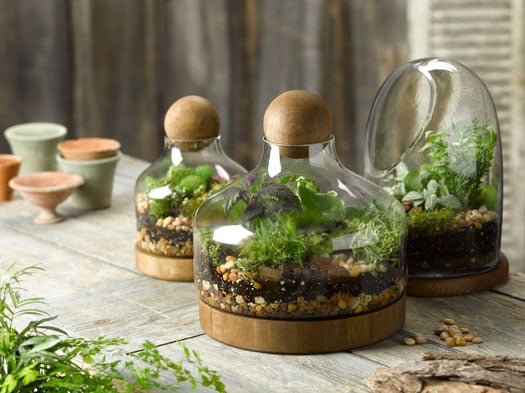The 2-Minute Rule for Terrarium Guides
Wiki Article
The Only Guide for Terrarium Guides
Table of ContentsGet This Report about Terrarium GuidesThe smart Trick of Terrarium Guides That Nobody is Talking AboutThe Greatest Guide To Terrarium GuidesHow Terrarium Guides can Save You Time, Stress, and Money.Not known Factual Statements About Terrarium Guides
Planning a terrarium, The initial step in planning a terrarium is to decide whether it will certainly be open (no lid or cover) or shut. Shut terrariums maintain one of the most moisture, adhered to by open terrariums and afterwards dish gardens. Open up terrariums and also recipe yards call for even more regular watering than do closed, yet danger of condition build-up is greater in the latter due to higher moisture.Containers with huge openings without covers can be utilized yet will certainly require more constant watering to maintain the high moisture required by some plants. Open terrariums are drier and also much less subject to disease.
A prepackaged peat-lite mix (blend of peat moss, vermiculite and perlite) is a superb choice. Potting soils cost garden centers and nurseries where plant products are offered are decontaminated and also all set for use. Expanding medium additionally can be prepared at residence. Mix one part peat moss with one component rich yard soil.
Select plants that suit the place. Many plants are ideal for growing in terrariums.
Indicators on Terrarium Guides You Need To Know
Few plants endure low-light problems for prolonged periods. Terrarium plants calling for intense light ought to be situated close to a home window, frequently in straight sun.A real terrarium is securely closed, as was Dr. Ward's initial instance. Several plants fit for terrariums need high moisture. An open container is one with high sides, generally at least as high as the plants had.
Plants not needing high moisture can be made use of. Lots of terrarium plants are tropical in nature and well fit for typical residence temperatures.
The awesome designation mostly fits woodland plants in woodland terrariums. These plants need to have night temperature levels of concerning 50 to 55 levels F. Locations with these temperature levels may be difficult to discover in the house, but in the winter, when plants are put on a windowsill near to the glass with the drapes pulled behind them, a pocket of trendy air will certainly develop.
The Of Terrarium Guides
Problems or attributes peculiar to the plant are recognized in the remarks area. Just a couple of tools are requirement to grow a terrarium. Use to dig openings, relocation things as well as assistance plants while they are being grown. The ideal size depends upon the elevation of the container. Use to trim plants before growing them.Use rocks, sand, wood and various other natural products to create cliffs, rock walks, dry streambeds or rich exotic woodlands. Wavinesses representing hills and also valleys will make the scene much more interesting than a flat surface area. Sketching a design of the terrarium before actually constructing it can be practical. Before growing, tidy and also disinfect the get redirected here within of the container by cleaning it with hot, soapy water and washing completely.
If a business glass cleanser is used, enable the open container to air for a number of days before planting. As a whole, concerning one quarter of the terrarium's volume must be made use of by the expanding tool and drainage product. These can be added quickly with a spoon, channel or other hassle-free tool.
If any type of diseases exist, they normally will end up being visible on the foliage or stems. Before adding the plants, arrange them in an open location regarding the size of the container to obtain a concept of loved one dimensions and also textural patterns. A low, coarse-textured plant is typically preferable for a dominant focal point near the front.
Terrarium Guides Things To Know Before You Get This
In a closed container, attempt to maintain vegetation from touching the sides of the container. Leaves touching the glass will certainly accumulate water and also be more subject to degeneration. Plants may be positioned in deep terrariums utilizing long slender tongs or a stick to a cord loop on completion. Deep containers with small openings will certainly call for substantial perseverance as well as technique in growing.Once the plant is the container, unwrap it and also remove the paper. This practice also assists maintain the within the container tidy. Before placing the plants, dig openings in the expanding medium with a pointed stick. After a plant has been positioned in a hole, fill in with expanding medium and also tamp to firm it.

Root rots often are related to excessive wetness. If rots create in a shut terrarium, remove the cover to enable even more drying out. If a fungi appears to be spreading out from a plant through the expanding medium, it may be valuable to get rid of a part of the check here tool in the infected area as well as replace it.
Excitement About Terrarium Guides
Most of the times, after a couple of weeks the terrarium is developed and also the risk of condition is lowered. Proceed to expect fallen leaves, nonetheless, or any kind of plant parts that begin to degeneration - terrarium guides. Care of the terrarium, A closed terrarium generally will not require water for 4 to 6 months.
Since plants in terrariums need to not proliferate, terrariums seldom require fertilizer. Do not fertilize for a minimum of a year after planting. If after the first year the plants appear yellowish and seem to do not have vigor without any type of various other apparent problems, a light fertilization may be essential. Use a water-soluble houseplant fertilizer at about one-fourth the rate recommended for normal houseplants.
:max_bytes(150000):strip_icc()/how-to-make-terrariums-848007-20-c54312d99b1348cfa3b827d389a5fbdb.jpg)
Report this wiki page